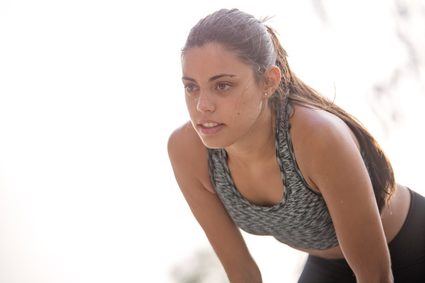VO2 Max Runners Calculator
VO2 max runners calculator is dedicated to all runners and other athletes who want to check their personal maximal oxygen consumption.
Knowing this critical parameter is essential for every endurance sports competitor to train consciously and effectively (see training pace calculator).
We prepared an article for you, where you can find some brief information about what VO2 max is, the highest VO2 max rates, and instructions for the calculator. Use our calculator and find your VO2 max value in seconds!

We try our best to make our Omni Calculators as precise and reliable as possible. However, this tool can never replace a professional doctor's assessment. If any health condition bothers you, consult a physician.
What is VO2 max?
VO2 max stands for maximal oxygen consumption or maximal aerobic capacity and refers to the amount of oxygen your body can utilize in one minute. It is one of the most popular indicators of physical efficiency, especially aerobic efficiency. It is a measure of your capacity for aerobic work.
VO2 can be a predictor of your potential as an endurance athlete (see race predictor calculator). Usually, athletes and trainers use the percentage value of VO2 max to express the intensity of training.
The VO2 value rises significantly in teenagers (both males & females) to achieve maximal levels in ages 18-20. It then gradually decreases with age.
VO2 max calculation – Jack Daniels' formula
The most reliable way to find your VO2 max is to have it done in a lab or gym, but you can also estimate it. There are a few proven methods that allow it. For runners, the most suitable way is Jack Daniels' formula. Based on it, you can estimate your parameters from a recent running race.
Daniels' formula assumes that to achieve reliable calculations, the race distance should be between about 1500 m and 50 km (about 1 mile and a marathon). Distances outside this range will not give meaningful results since performance is limited by factors other than VO2 max.
The formulas are:
where is the race time in minutes, and is race velocity in meters / minute.
💡 You also might find interesting our race time improvement calculator.
VO2 max runners calculator – how to use it?
Let's go through the example to see how properly use the calculator:
-
First, enter your recent race distance.
For calculations, we assume
run distance = 10 km. -
Then, fill in the recent race time.
For example,
run time = 48 min 12 sec. -
Now you can see your estimated VO2 levels:
VO2 max = 41.77 ml/kg/minVO2 based on your race pace = 37.69 ml/kg/min,which is equal
90.24 % of VO2 max.
What are the VO2 norms?
The average untrained healthy males reach VO2 max of approximately 35-40 ml/kg/min. The average untrained healthy female scores a VO2 max of approximately 27–31 ml/kg/min. These values can improve with training and decrease with age.
A degree of trainability may vary widely – some individuals can double their VO2 max with training, but some will never improve it, even despite regular exercising. The examples of maximal oxygen consumption (ml/kg/min) are listed below:
Gender | Age | Poor | Fair | Average | Good | Excellent |
|---|---|---|---|---|---|---|
Men | under 29 | under 24.9 | 25-33.9 | 34-43.9 | 44-52.9 | over 53 |
30-39 | under 22.9 | 23-30.9 | 31-41.9 | 42-49.9 | over 50 | |
40-49 | under 19.9 | 20-26.9 | 27-38.9 | 39-44.9 | over 45 | |
50-59 | under 17.9 | 18-24.9 | 25-37.9 | 38-42.9 | over 43 | |
60-69 | under 15.9 | 16-22.9 | 23-35.9 | 36-40.9 | over 41 | |
Women | under 29 | under 23.9 | 24-30.9 | 31-38.9 | 39-48.9 | over 50 |
30-39 | under 19.9 | 20-27.9 | 28-36.9 | 37-44.9 | over 45 | |
40-49 | under 16.9 | 17-24.9 | 25-34.9 | 35-41.9 | over 42 | |
50-59 | under 14.9 | 15-21.9 | 22-33.9 | 34-39.9 | over 40 | |
60-69 | under 12.9 | 13-20.9 | 21-32.9 | 33-36.9 | over 37 |
Data are based on "Essentials of Exercise Physiology, 3rd ed., W. D. McArdle, F.I. Katch, V. L. Katch, Lippincott Williams and Wilkins, Philadelphia, PA USA 2006".
Highest VO2 max
Professional athletes are able to achieve very high VO2 levels – especially those who compete in endurance disciplines like running, cycling, or cross-country skiing. Such high numbers are out of range for most of us amateur sportspeople. For sure, many years of tough training stimulate your body to achieve better results, but, as mentioned above, natural predispositions matter a lot. Take a look at the list below with a few VO2 record holders.
-
Highest recorded female (cross-country skier): 74 ml/kg/min;
-
Highest recorded male (cross-country skier): 94 ml/kg/min;
-
Greg LeMond (professional cyclist) 92.5 ml/kg/min;
-
Miguel Indurain (professional cyclist): 88 ml/kg/min;
-
Steve Prefontaine (US runner): 84.4 ml/kg/min;
-
Jeff Galloway (US Runner): 73.0 ml/kg/min;
-
Frank Shorter (US Olympic Marathon winner): 71.3 ml/kg/min;
-
Jarmila Krotochvilova (Czech Olympian 400M/800M winner): 72.8 ml/kg/min;
-
Ingrid Kristiansen (ex-Marathon World Record Holder): 71.2 ml/kg/min; and
-
Paula Ivan (Russian Olympic 1500M Record Holder): 71.0 ml/kg/min.
Another running calculator we have is the marathon pace calculator. 🏃
How do I improve my VO2 max?
The following actions will help you increase your VO2 max:
- High-intensity training (90-95% of your maximum heart rate);
- Increasing the duration, frequency, or intensity of your training; and
- Performing the interval training.
What is my VO2 max if I can run 10 km in 55 mins?
Your VO2 max is 35.774 ml/kg/min. This result is based on the so-called Daniels' formula.